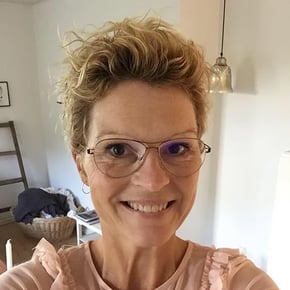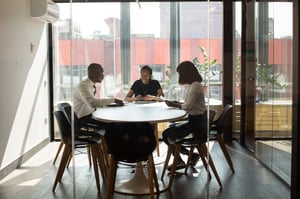The following post is a guest post from RUMAS, a Danish office space design company.
How to design your modern meeting rooms to achieve more effective and creative meetings
You know how it goes. On Monday morning, the accounts department has appropriated the company meeting room. After lunch, the creative department needs it for great ideas and mock-ups. In the evening, there will be a board meeting – and already Tuesday morning there are job interviews. That is how it is with meeting rooms. They keep having different events with different objectives – and that generates challenges and makes it hard to design the rooms so that they always match the different objectives. This is where you need to bring intelligent design into your solutions.
How do you design the meeting rooms intelligently?
This is about creating interaction between colors, forms, interior and functionality, so as much attention is focused on the objective of the individual meeting as on tables, chairs and equipment. It should feel pleasant to come into a meeting room. Here, colors are important – and even if it is tempting to pick a fresh and striking color for the walls, a cheeky Ferrari red may distract the focus from an otherwise serious meeting. On the other hand, a pale beige and anonymous yellow can suck the life out of a group of creative designers. So the task is to find the fine balance between a big bang effect and something quieter and calmer. With luck, one can benefit here from the interior features of the room: cupboards, tables, floor, lamps, etc. - and if one makes it possible to swap features and move them around, one can at any time decorate the room according to the purpose and functionality with a mixture of colors, forms and lighting.
This is how you get an overview of your possibilities
How do you discover what tools are needed to equip the intelligent meeting room?
Start by defining the different needs that the various departments and individuals in the company have in connection with meetings. Have a chat about the different meeting types where many people participate, how long the meetings last, what happens, etc. After that, you can divide the different needs according to the type of meetings – and set them up in relation to the number of meeting rooms available in your company.
If you have several meeting rooms, it is a good idea to divide them up and design each according to function and purpose. Again, the need is to get an overview of needs. A office space utilization analytics software will provide you with an overview of earlier activities and thereby get an insight into how the individual meeting rooms have been booked and worked in the past – what was good, what failed to work at all.
Now the next step is to bring tables, chairs, lamps and other interior features into your solutions.
Get an overview of what sort of meetings you hold – then you will know which features you need
If you have several meeting rooms in the company, it is a good idea to divide them up according to the purpose of the different meetings - otherwise your meeting rooms can become a productivity killer. If you have the chance to design one of the meeting rooms with a focus on development and creativity, another with a focus on discussions and cooperation and a third with a focus on customer meetings, presentations, and negotiations, it is obvious that they should be designed differently, although with the potential to swap the interior features according to the purpose of the individual meetings. After all, there is no guarantee that 3 different meetings are held at the same time – in the company, there will often be several customer meetings, presentations, development discussions and much more at the same time. This makes it nice to be able to change the look of the room with limited resources, by taking pictures down from the walls, swap the chairs, remove a table or two – and if the possibilities have been thought of from the beginning, it is easy to make small changes with major effects and stay up to date with current workplace design trends.
This is how you choose furniture and other features for your modern meeting rooms
There are many factors to consider when you choose furniture and other features. Should you have furniture which can be used for as many events as possible – both the serious ones and the more informal ones – or should it match a particular purpose, e.g. a board meeting? Does the interior need to be able to be altered according to the purpose of the meeting, are the tables scalable, which chairs work best for both working and relaxing, how does one store the furniture – and where? And how does the design of the furniture affect the individual meeting participants and their behavior?
The individual types of furniture and interior features – and their effect on the users
Round tables, high tables, chairs without arms, chairs with arms, soft and calm colors, wild and challenging colors, pictures on the wall, signs that communicate, soft carpets, polish wooden floors, lamps and much more contribute to setting the agenda for the meetings that are held. When the design is made, it is therefore a good idea to think over the purpose of the meetings to be held in the individual rooms and you can use meeting room analytics to design your workplace to optimize productivity.
The informal quick meeting
We know that a high table with highchairs encourages a short meeting. One can also leave out the chairs and just stand up, which quite clearly indicates that it is only going to be a quick chat. One can certainly drink a cup of coffee or iced water while chatting. Perhaps a bit loosely and informally about a coming project, relaxed, one leans slightly over the table or in a Activity-based Workingstyle which may even be located in an open-plan room where others are working at the same time.
Meeting room or modern workplace?
A round table in the meeting room will encourage a discussion. The round table creates the basis for a good and inspiring discussion, perhaps a creative meeting to start a larger project, perhaps an internal presentation of a project before meeting the customer – the round table makes it possible to inform, share knowledge, make plans, and have equal standing. At the same time, the round table – depending on the type and design – can be mixed with square units and thereby converted to a large, long table with space for more participants.
Soft chairs and serious negotiations
In a very large meeting room with a rectangular meeting table and soft chairs, e.g. conference chairs with arm rests, one can invite participants to a longer discussion and more serious negotiations. In this way, you signal to the participants that they can safely lean back and prepare for a more serious meeting.
Colors are needed too
Some may say cheerful colors, others will say calmer colors. Again, the most important is to consider the function of the room vs. the purpose of the meeting in the context. A big bang with powerful colors can both generate energy and distract. Here one can think of colors and patterns working like sounds – the louder they are, the more wildly the orchestra plays, the greater the risk that the music determines the progress of the discussion. One should therefore choose more neutral color tones, which also give a better background to display artwork. And artwork can be moved, pictures can be exchanged, sculptures can be removed. In this way, one creates a better flow in the meeting room – a flow that helps precisely support the purpose of the meeting.
Rikke Kragelund from RUMAS works actively in the design of meeting rooms. The inspiration comes as much from the furniture and interior features which the company provides as from discussions with the customers who want more effective and creative meeting rooms. She says:
“Meeting rooms often have many different functions. One day the room is to facilitate a staff meeting, next morning four job interviews are to be carried out, followed by a creative playroom with a need for mock-ups, big posters, and even bigger arm gestures – and then in the evening the room is to be used for a board meeting. Consequently, the furniture and other interior features need to able to be set up quickly and to change function easily – while dividing walls, blinds etc. need to be able to change color and appearance.”
Rikke Kragelund, who is responsible for marketing at RUMAS, continues:
Need for modern meeting rooms
At Rumas, we have worked for a long time to help and guide our sales staff and customers to ensure optimal benefits from their meeting activities with the help of design and features. The customers often express a need for more than just office furniture – they also want new access to more effective meetings, opportunities to change the look in the meeting room and increase the flexibility of the design as well as inspiration and creative ideas.
The purpose of the meeting determines the functionality of the room
Making a meeting room effective simply means that it should adjust to the participants and the purpose - not the reverse. Rumas’ interior designers help to define the different functions of the rooms by interaction with the needs of the users – and thereby to design the individual meeting room in a way that matches the purpose of the individual meeting
Next, we can help you decide what to call your next modern meeting room in our free e-book with 160+ meeting room name ideas.




